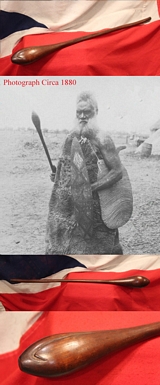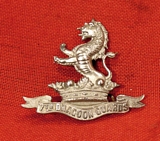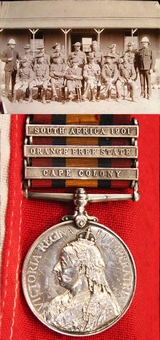Antique Arms & Militaria
A Most Scarce Antique Australian Aboriginal Throwing Club, Carved Head
Nulla Nulla, Aboriginal, short, possibly mulga wood, very dense hardwood, throwing club with ovoid shaped head, used for hunting, fighting and ceremonial purposes, [South East] Australia, 1860. A waddy, nulla nulla or hunting stick is an Aboriginal Australian club for use in hunting and fighting. The first of these names comes from the Dharuk Aborigines of Port Jackson, Sydney.
A waddy is a heavy, pointed club constructed of carved timber. Waddies have been used in hand-to-hand combat, and were capable of splitting a shield, and killing or stunning prey. In addition to this they could be employed as a projectile as well as used to make fire and make ochre. They found further use in punishing those who broke Aboriginal law, which often involved settling a conflict between individuals, or between an individual and a group, in a 'Trial by Ordeal' in which fighters gave and suffered heavy blows resulting in skull and bone fractures and much blood read more
375.00 GBP
Antique Zulu-Tsonga Prestige Staff Possibly Carved by a Carver Known as the 'Baboon Master'. With a Carved Female Head
19th century. This dignatory's staff has a most figurative carving. They have been collected in Southern Africa since the mid-19th century. Recent research by Anitra Nettleton suggests, however, that Tsonga sculptors may actually have produced most of these carvings. There is evidence that the Tsonga migrated to the Natal from southern Mozambique as early as the 1850s. Recognized for their carving skills, they were soon producing fine artifacts for Zulu dignatories. Two related staffs, were purchased for the collection of the Standard Bank Foundation in Johannesburg. One staff of theirs is surmounted by a baboon and the other by a male figure with a beard. Both are said to be turn-of-the-century staffs carved by the same hand, by a most accomplished and sought after artist dubbed the 'Baboon Master', who was possibly of Tsonga origin. 31 inches long. read more
750.00 GBP
A Rare 19th Century King's Knife of the Zande or the Mengbetu People, A Trombash Power Authority Knife
A long Knife consisting of a short cylindrical wooden handle, round in section, with a flat end bound in iron banding at the pommel end. The other end of this is cut flat, and has a smaller cylindrical body as the middle hand grip section. Above this point, the handle connects with the blade tang. Which goes through the handle, the tang has been inserted through the centre of the handle, and then its rectangular end hammered over at the top to fix it in place. This is end is visible where it emerges through the handle top, and is off centre. The narrower part of the handle have been decorated with an iron binding strip. Both binding strips [top and bottom] have their ends hammered into slots in the wood to secure them. The blade is curved, with a broad flat ridge running along the length on both sides. This is not centred. On one side of the ridge, the blade extends to form a broad, sharpened base edge with a pointed corner; a more narrow blade extends from the other side of this, slightly higher up the knife. The sides then begin to taper in towards the point at the other end. Both edges were once sharpened. The object is complete, with some minor cut marks on the blade and handle.
Very similar to a Mengbetu collected by Robert Grenville Gayer-Anderson in the Bahr el Ghazal region, probably between 1909 and 1914, in the period immediately before World War I. At the time this object was collected, the Bahr el Ghazal province was much larger than it is today, extending from roughly the Bahr el Arab all the way to the border with the Belgian Congo; this area is now divided into the districts of Western Bahr el Ghazal, Northern Bahr el Ghazal, and parts of Warab, El Buheyrat and Western Equatoria. The drawing in the gallery is a 19th century depiction of Munza, the king of the Mangbetu. Seated on his throne, he holds a similar knife to ours as a symbol of power and authority. read more
395.00 GBP
A Beautiful Sword of the Mandinka, West African, with Elaborate Decorative Fittings 20th. Century
Curved on both sides, fluted back blade with baluster contrast stitching and leather-covered handle. Geometrically patterned leather scabbard with traditional banding patterns, stitched raffia decorations and braided suspension cords and leather fringe tassels.
In some areas they are referred to locally as termed a 'kota' and that the scabbard was termed 'holga' ( house 'for the sword')
The Mandinka are the descendants of the Mali Empire, which rose to power in the 13th century under the rule of king Sundiata Keita, who founded an empire that would go on to span a large part of West Africa. They migrated west from the Niger River in search of better agricultural lands and more opportunities for conquest. Nowadays, the Mandinka inhabit the West Sudanian savanna region extending from The Gambia and the Casamance region in Senegal to Ivory Coast. Although widespread, the Mandinka constitute the largest ethnic group only in the countries of Mali, Guinea and The Gambia. Most Mandinka live in family-related compounds in traditional rural villages. Their traditional society has featured socially stratified castes.Mandinka communities have been fairly autonomous and self-ruled, being led by a chief and group of elders. Mandinka has been an oral society, where mythologies, history and knowledge are verbally transmitted from one generation to the next. Their music and literary traditions are preserved by a caste of griots, known locally as jelis, as well as guilds and brotherhoods like the donso (hunters).
Between the 16th and 19th centuries, many Muslim and non-Muslim Mandinka people, along with numerous other African ethnic groups, were captured, enslaved and shipped to the Americas. They intermixed with slaves and workers of other ethnicities, creating a Creole culture. The Mandinka people significantly influenced the African heritage of descended peoples now found in Brazil, the Southern United States and, to a lesser extent, the Caribbean read more
195.00 GBP
A Most Charming Napoleonic Wars King George IIIrd Royal Scot's Greys Officer's Carved Horn, Campaign Drinking Cup
In carved horn used from the 1790's by a British Napoleonic Wars officer in the Royal Scot's Greys, then by his grandson in the Crimean war. A super Napoleonic Wars collectable.
Campaign furniture is an umbrella term for the portable items of furniture used by the military in the eighteenth, nineteenth and early twentieth centuries. It is comprised of a huge number of objects, from leatherwork, knives and forks, flasks, drinking vessels, chairs to chests, wardrobes to washstands and games tables to camp beds. from chairs to chests, wardrobes to washstands and games tables to camp beds. A number of celebrated British furniture makers created pieces of campaign furniture, elevating it beyond its roots in functional, army-based design to desirable, collectable decor that continues to add a beautiful, innovative touch to homes today. read more
145.00 GBP
A Most Scarce and Beautiful African Congo Tribal Warrior's Shield, of the Mongo Tribe.
Long ovoid form shield with stunning geometric pattern decoration. Carved wood with rattan bound edging.
The Mongo are one of the Bantu groups of Central Africa, forming the second largest ethnic group in the Democratic Republic of Congo. They are a diverse collection of peoples living in the equatorial forest, south of the main Congo River bend and north of the Kasai and Sankuru Rivers. This area is in the south of the province of Equateur and the north of Bandundu Province.
The Mongo speak either the Mongo language (also called Nkundo) or one of the related languages in the Bantu Mongo family. The Lingala language, however, often replaces Mongo in urban centers. Along with the Luba and the Kongo, they are the three largest ethnic groups in the country.
The Mongo ethnic group is divided into several tribes including Bolia, Bokote, Bongandu, Iyaelima, Konda, Mbole, Nkutu, Ntomba, Sengele, Songomeno, Dengese and Tetela-Kusu, Bakutu, Boyela.
Antique & Vintage original African tribal art is now some of the most desirable and sophisticated decor for national and international interior decorators.
Fine tribal artefacts have always been highly popular and in regards to interior decor, the height of sophistication, but recently it has become absolutely 'the' collectable art of the moment. As to be seen from far afield interiors such as in the 8th Arrondissement, in Paris particularly Avenue Montaigne, to Park Avenue New York, to Kensington Palace Gardens in London or the Piazza di Spagna, Via Condotti and Via del Babuino in Rome. All of the above we have had clients for such African tribal art and weaponry, as a statement focal point for their interior decor.
Super colour contrasts and design incorporating red ochre, cobalt blue, black and white. Red ochre is one of the very earliest pigments used by man, dating back to prehistoric times where it’s use is the basis of many Stone Age cave paintings
Overall in very good condition for age.
16 inches x 35 inches read more
875.00 GBP
A Magnificent & Fabulous Quality Antique French Rococo Silver Table Lamp
A wonderful example of the finest antique silver plate. Superlative quality of the highest grade, and of the most incredible beauty, from the Rococo Revival period that emerged from the King Louis Phillipe and Second Empire eras in France, and was then adapted in England. Revival of the rococo style was seen all throughout Europe during the 19th century within a variety of artistic modes and expression including decorative objects of art, paintings, art prints, furniture, and interior design. In much of Europe and particularly in France, the original rococo was regarded as a national style, and to many, its re-emergence recalled national tradition. Rococo revival epitomized grandeur and luxury in European style and was another expression of 19th century romanticism and the growing interest and fascination with natural landscape. Louis Philippe (1830-1848)
The rising bourgeoisie in France demanded rococo decorative-art objects as a reflection of status, wealth, and material possession. The bourgeois consumer purchased objects and furnishings from a variety of revival styles, including rococo, for its significance in historicizing opulence and grandeur.
Modern French Rococo furniture and decorative arts were characterized by their opulence elegance and grace. Its ornamentation consisted of delicate foliage and intricate details.13.5 inches x 8 inches. Excluding light fitting. Very heavy quality. read more
895.00 GBP
Original Victorian 7th Dragoon Guards Silver Cap Badge, 1898 1906
A superb example in pristine condition, not hallmarked silver. Crisp and sharp and superb quality. Part of a small collection of original rare Victorian badges we have just been most pleased to acquire. At Dettingen, Cornet Richardson of the 7th received thirty-seven wounds whilst defending the Regimental Standard. This standard is the oldest surviving in the British Army.
7th Dragoon horsemen carried out the last cavalry charge of World War 1 when they galloped for 10 miles to capture LESSINES in BELGIUM and the crossings there over the RIVER DENDRE suffering no casualties themselves, but taking 4 German officers and 167 men prisoners. As was required by higher command this action was completed as the clocks were striking 11 o?clock when hostilities had to stop in accordance with the terms of the Armistice. read more
75.00 GBP
A Queen's South Africa Medal to South African Constabulary Cavalryman.
A rare medal of the Boer War with three bars. Issued to 3rd Class Trooper R.G,Phillips.. 12 squadrons of the SAC were raised in Canada by General Baden-Powell. Many Canadians stayed on to live there after the war's end. One photo in the gallery of a group of SAC probably outside the HQ at Koffiefontein read more
245.00 GBP
A Super & Rare US Civil War Souvenir, An Original US Cavalry Gallagher Carbine Stock.
Ideal for the collector of rare Civil War arms that is not necessarily inclined to buy a full rifle for the several thousands of pounds it would cost, or, for an owner of a Gallagher that needs a replacement stock. If needed as such, it would normally be simply impossible to find an original example, in such wonderful condition, ever available on the collector market.
Fine walnut stock, with all steel furniture including the steel hinged patchbox, steel butt plate and side screw mounts. In superb condition and three figure serial number, 257 [repeated], stamped on the inner steel patch box lid. On the underside are several crudely carved notches, traditionally, are supposed to represent enemy soldiers that have been successfully 'introduced' to the horse soldier's shooting prowess.
The Gallager Carbine was conceived in 1860 by Mahlon J. Gallager. Receiving his patent on the 17th of July 1860, Gallager submitted his design to military trials. The design was approved and Federal forces issued a contract for Richardson and Overman of Philadelphia to produce the carbine. This contract resulted in 22,728 Gallagers to be produced before the end of the American Civil War, which was more than some other breechloading rifles (such as the Joslyn Rifle or Starr Carbine) but no where near as many as the Springfield Model 1861 rifled musket (whose production passed over 1,000,000 during the conflict).
The Gallager Carbine had a rather unusual breechloading design, using a modified version of the more typical lever-action mechanism to open the breech. As was the trend at the time, the lever effectively formed the trigger guard , and when pulled downwards slid the barrel forwards, before tiliting downwards. This then allowed the user to remove the spent cartridge (most commonly with a knife) and insert the new cartridge. The barrel was then pushed back into place, then locked when the lever was put into its upwards position, ready for firing.
Initially the Gallager was manufactured utilising a percussion lock mechanism, largely due to the fact that the quickest (and cheapest) cartridges to produce at the time were made of paper. This mechanism was not modified on later models, despite the use of metallic cartridges. Other features of the Gallager included iron fittings (ie the buttplate of the stock and patchbox) and a lack of a forestock.
The lack of a forestock is not that much of a suprise, however, as the shorter stock meant that the barrel could tilt once it had moved forwards (otherwise the barrel would have to have been allowed to move further to allow the user to load the new cartridge). Furthermore, because there was a lack of a forestock, the Gallager also lacked any form of barrel bands and also lacked the ability to have a bayonet mounted to it. The barrel itself had six grooves forming the rifling pattern and measured 22.25in (0.57m) in length.
Photo in the gallery of a US Civil War Horse Soldier with his carbine, sabre and revolver, also a photo of the complete Civil War Gallaghar Carbine in the Smithsonian read more
450.00 GBP











